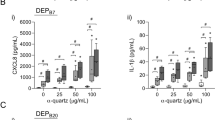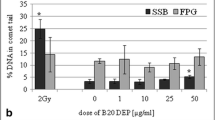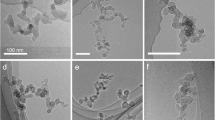Abstract
An in vitro reporter gene assay based on human breast cancer T47D cells (ER-CALUX®) was applied to examine the ability of diesel exhaust to induce or inhibit estrogen receptor (ER)-mediated gene expression. Exhaust from a heavy-duty diesel engine was either treated by iron- or copper/iron-catalyzed diesel particulate filters (DPFs) or studied as unfiltered exhaust. Collected samples included particle-bound and semivolatile constituents of diesel exhaust. Our findings show that all of the samples contained compounds that were able to induce ER-mediated gene expression as well as compounds that suppressed the activity of the endogenous hormone 17β-estradiol (E2). Estrogenic activity prevailed over antiestrogenic activity. We found an overall ER-mediated activity of 1.63 ± 0.31 ng E2 CALUX equivalents (E2-CEQs) per m3 of unfiltered exhaust. In filtered exhaust, we measured 0.74 ± 0.07 (iron-catalyzed DPF) and 0.55 ± 0.09 ng E2-CEQ m−3 (copper/iron-catalyzed DPF), corresponding to reductions in estrogenic activity of 55 and 66%, respectively. Our study demonstrates that both catalytic DPFs lowered the ER-mediated endocrine-disrupting potential of diesel exhaust.





Similar content being viewed by others
Abbreviations
- AhR:
-
Aryl hydrocarbon receptor
- ANOVA:
-
One-way analysis of variance
- Cl:
-
Chlorine-enriched diesel fuel (14 μg g−1)
- Cu:
-
Diesel fuel with copper/iron-based fuel additive (9.0/7.5 μg g−1)
- DMSO:
-
Dimethylsulfoxide
- DPF:
-
Diesel particulate filter
- E2:
-
17β-Estradiol
- EE2:
-
17α-Ethinylestradiol
- E2-CEQ:
-
17β-Estradiol CALUX equivalent
- ER:
-
Estrogen receptor;
- ER-CALUX® :
-
Estrogen Responsive–Chemically Activated LUciferase eXpression
- F:
-
Exhaust treatment by diesel particulate filter
- FBS:
-
Fetal bovine serum
- Fe:
-
Diesel fuel with iron-based additive (4.5 μg g−1)
- PCDD/Fs:
-
Polychlorinated dibenzodioxins/furans
- Ref:
-
Reference diesel fuel
- RSD:
-
Relative standard deviation
- xCl:
-
Chlorine-enriched diesel fuel (110 μg g−1)
References
van Setten BAAL, Makkee M, Moulijn JA (2001) Catal Rev 43:489–564
Zhu Y, Hinds WC, Kim S, Shen S, Sioutas C (2002) Atmos Environ 36:4323–4335
Heeb NV, Zennegg M, Gujer E, Honegger P, Zeyer K, Gfeller U, Wichser A, Kohler M, Schmid P, Emmenegger L, Ulrich A, Wenger D, Petermann J-L, Czerwinski J, Mosimann T, Kaspar M, Mayer A (2007) Environ Sci Technol 41:5789–5794
Riedl M, Diaz-Sanchez D (2005) J Allergy Clin Immunol 115:221–228
Delfino RJ, Sioutas C, Malik S (2005) Environ Health Perspect 113:934–946
Brüske-Hohlfeld I, Möhner M, Ahrens W, Pohlabeln H, Heinrich J, Kreuzer M, Jöckel K-H, Wichmann H-E (1999) Am J Indust Med 36:405–414
Wenger D, Gerecke AC, Heeb NV, Zennegg M, Kohler M, Naegeli H, Zenobi R (2008) Environ Sci Technol (in press, DOI 10.1021/es071827x)
Furuta C, Suzuki AK, Taneda S, Kamata K, Hayashi H, Mori Y, Li CM, Watanabe G, Taya K (2004) Biol Reprod 70:1527–1533
Sidhu S, Gullett B, Striebich R, Klosterman J, Contreras J, DeVito M (2005) Atmos Environ 39:801–811
Colborn T, vom Saal FS, Soto AM (1993) Environ Health Perspect 101:378–384
World Health Organization (WHO), International Labour Organisation (ILO), United Nations Environment Programme (UNEP) (2002) Global assessment of the state-of-the-science of endocrine disruptors. In: T. Damstra, Sue Barlow, Aake Bergman, Robert Kavlock, Glen van der Kraak (eds). International Programme on Chemical Safety (ICPS)
Legler J, van den Brink CE, Brouwer A, Murk AJ, Van der Saag PT, Vethaak DA, Van der Burg B (1999) Toxicol Sci 48:55–66
Nilsson S, Mäkelä S, Treuter E, Tujague M, Thomsen J, Andersson G, Enmark E, Pettersson K, Warner M, Gustafsson J-Å (2001) Physiol Rev 81:1535–1565
Villeneuve DL, Blankenship AL, Giesy JP (1998) Interactions between environmental xenobiotics and estrogen receptor-mediated responses. In: Denison, MS, Helferich, WG (eds) Toxicant–receptor interactions. Taylor & Francis, Philadelphia, PA
Howell A, Osborne KC, Morris C, Wakeling AE (2000) Am Cancer Soc 817–825
Safe S, Wormke M (2003) Chem Res Toxicol 16:807–816
Meek MD (1998) Environ Res 79:114–121
Okamura K, Kizu R, Toriba A, Klinge CM, Hayakawa K (2002) Polycycl Aromat Comp 22:747–759
Wang J, Wu W, Henkelmann B, You L, Kettrup A, Schramm KW (2003) Atmos Environ 37:3225–3235
Watanabe N, Kurita M (2001) Environ Health Perspect 109:111–119
Watanabe N (2005) Toxicol Lett 155:51–58
Takeda K, Naomi T, Yoshida S (2004) Environ Sci 11:033–045
Yoshida S, Takeda K (2004) J Health Sci 50:210–214
Ono N, Oshio S, Niwata Y, Yoshida S, Tsukue N, Sugawara I, Takano H, Takeda K (2007) Inhal Tox 19:275–281
Guo J, Kauppinen T, Kyyronen P, Heikkila P, Lindbohm ML, Pukkala F (2004) Int J Cancer 111:286–292
De Rosa M, Zarrilli S, Paesano L, Carbone U, Boggia B, Petretta M, Maisto A, Cimmino F, Puca G, Colao A, Lombardi G (2003) Hum Reprod 18:1055–1061
Schaefer-Sindlinger A, Lappas I, Vogt CD, Ito T, Kurachi H, Makino M, Takahashi A (2007) Top Catal 42–43:307–317
Schwarzenbach RP, Gschwend PM, Imboden DM (2003) Environmental organic chemistry. Wiley, Hoboken, NJ
Ulrich A, Wichser A (2003) Anal Bioanal Chem 377:71–81
CEN (1996) European Standard EN 1948-1. European Committee for Standardization (CEN), Brussels
Wenger D, Gerecke AC, Heeb NV, Zenobi R (2006) Organohal Comp 68:1295–1298
Van Wouwe N, Windal I, Vanderperren H, Eppe G, Xhrouet C, Massart A-C, Debacker N, Sasse A, Baeyens W, De Pauw E, Sartor F, Van Oyen H, Goeyens L (2004) Talanta 63:1157–1167
Martin OV, Lai KM, Scrimshaw MD, Lester JN (2005) Environ Sci Technol 39:5349–5355
Schmidt JV, Bradfield CA (1996) Annu Rev Cell Dev Biol 12:55–89
Clemons JH, Allan LM, Marvin CH, Wu Z, McCarry BE, Bryant DW, Zacharewski TR (1998) Environ Sci Technol 32:1853–1860
Wang J, Xie P, Xu Y, Kettrup A, Schramm K-W (2004) Atmos Environ 38:6157–6166
Acknowledgements
We thank all our collaborators at Empa, BFH-TI Biel, and TTM Niederrohrdorf for providing exhaust samples and know-how. This study was supported by the board of Empa and the Swiss National Science Foundation (NRP50 program, grant no. 40504–104378).
Author information
Authors and Affiliations
Corresponding author
Electronic supplementary material
Below is the link to the electronic supplementary material.
ESM 1
(DOC 548 kb)
Rights and permissions
About this article
Cite this article
Wenger, D., Gerecke, A.C., Heeb, N.V. et al. Catalytic diesel particulate filters reduce the in vitro estrogenic activity of diesel exhaust. Anal Bioanal Chem 390, 2021–2029 (2008). https://doi.org/10.1007/s00216-008-1872-8
Received:
Revised:
Accepted:
Published:
Issue Date:
DOI: https://doi.org/10.1007/s00216-008-1872-8




